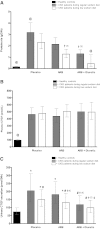Effects of antiproteinuric intervention on elevated connective tissue growth factor (CTGF/CCN-2) plasma and urine levels in nondiabetic nephropathy
- PMID: 21784839
- PMCID: PMC3359537
- DOI: 10.2215/CJN.08190910
Effects of antiproteinuric intervention on elevated connective tissue growth factor (CTGF/CCN-2) plasma and urine levels in nondiabetic nephropathy
Abstract
Background and objectives: Connective tissue growth factor (CTGF/CCN-2) is a key player in fibrosis. Plasma CTGF levels predict end-stage renal disease and mortality in diabetic chronic kidney disease (CKD), supporting roles in intra- and extrarenal fibrosis. Few data are available on CTGF in nondiabetic CKD. We investigated CTGF levels and effects of antiproteinuric interventions in nondiabetic proteinuric CKD.
Design, setting, participants, & measurements: In a crossover randomized controlled trial, 33 nondiabetic CKD patients (3.2 [2.5 to 4.0] g/24 h proteinuria) were treated during 6-week periods with placebo, ARB (100 mg/d losartan), and ARB plus diuretics (100 mg/d losartan plus 25 mg/d hydrochlorothiazide) combined with consecutively regular and low sodium diets (193 ± 62 versus 93 ± 52 mmol Na(+)/d).
Results: CTGF was elevated in plasma (464 [387 to 556] pmol/L) and urine (205 [135 to 311] pmol/24 h) of patients compared with healthy controls (n = 21; 96 [86 to 108] pmol/L and 73 [55 to 98] pmol/24 h). Urinary CTGF was lowered by antiproteinuric intervention, in proportion to the reduction of proteinuria, with normalization during triple therapy (CTGF 99 [67 to 146] in CKD versus 73 [55 to 98] pmol/24 h in controls). In contrast, plasma CTGF was not affected.
Conclusions: Urinary and plasma CTGF are elevated in nondiabetic CKD. Only urinary CTGF is normalized by antiproteinuric intervention, consistent with amelioration of tubular dysfunction. The lack of effect on plasma CTGF suggests that its driving force might be independent of proteinuria and that short-term antiproteinuric interventions are not sufficient to correct the systemic profibrotic state in CKD.
Figures


References
-
- Leask A, Abraham DJ: TGF-beta signaling and the fibrotic response. FASEB J 18: 816–827, 2004 - PubMed
-
- Yokoi H, Sugawara A, Mukoyama M, Mori K, Makino H, Suganami T, Nagae T, Yahata K, Fujinaga Y, Tanaka I, Nakao K: Role of connective tissue growth factor in profibrotic action of transforming growth factor-beta: A potential target for preventing renal fibrosis. Am J Kidney Dis 38: S134–S138, 2001 - PubMed
-
- Qi W, Chen X, Poronnik P, Pollock CA: Transforming growth factor-beta/connective tissue growth factor axis in the kidney. Int J Biochem Cell Biol 40: 9–13, 2008 - PubMed
-
- Yokoi H, Mukoyama M, Mori K, Kasahara M, Suganami T, Sawai K, Yoshioka T, Saito Y, Ogawa Y, Kuwabara T, Sugawara A, Nakao K: Overexpression of connective tissue growth factor in podocytes worsens diabetic nephropathy in mice. Kidney Int 73: 446–455, 2008 - PubMed
-
- Wang S, Denichilo M, Brubaker C, Hirschberg R: Connective tissue growth factor in tubulointerstitial injury of diabetic nephropathy. Kidney Int 60: 96–105, 2001 - PubMed
Publication types
MeSH terms
Substances
LinkOut - more resources
Full Text Sources
Medical
Miscellaneous

